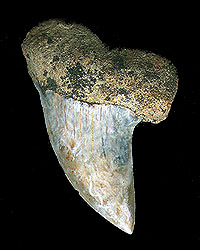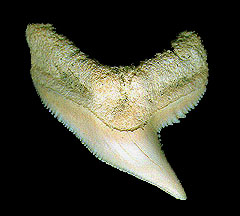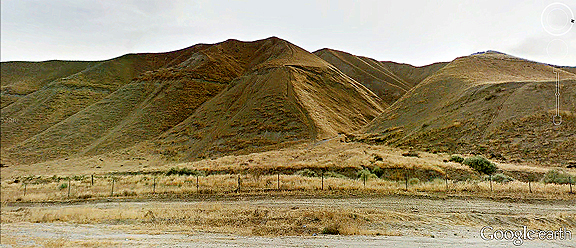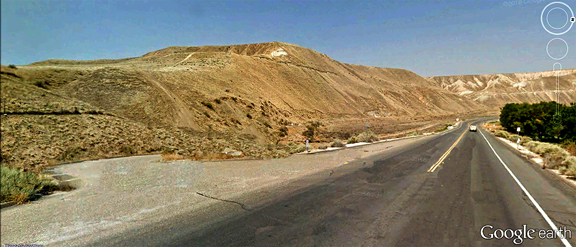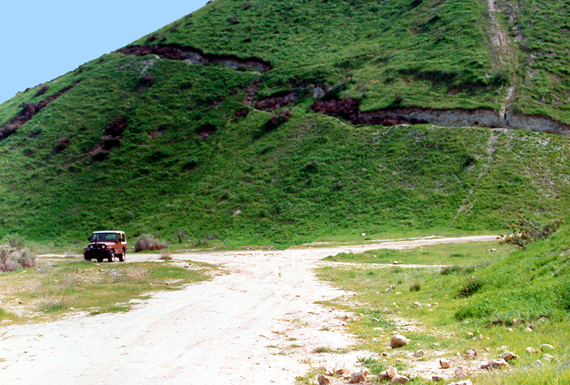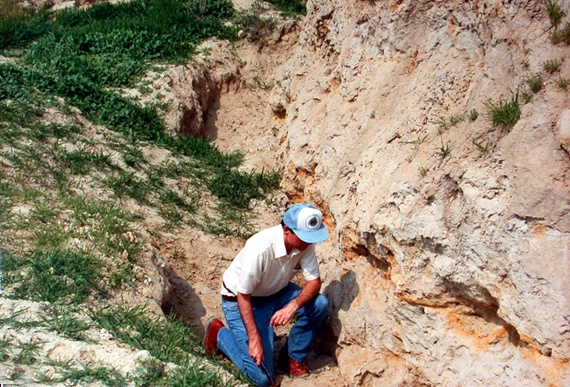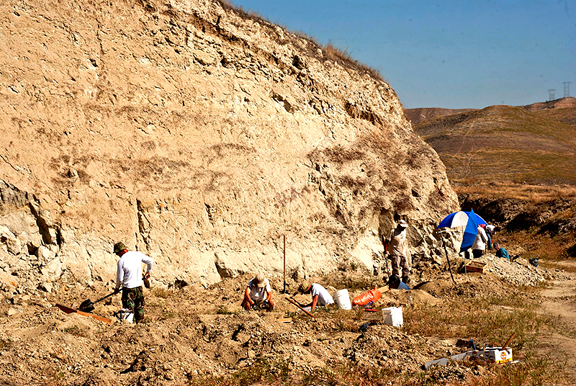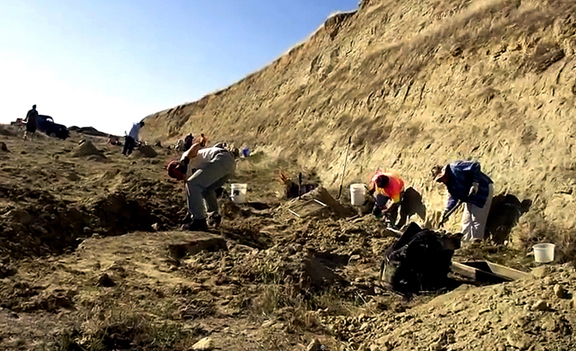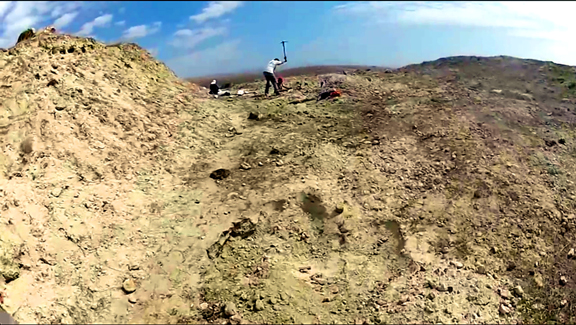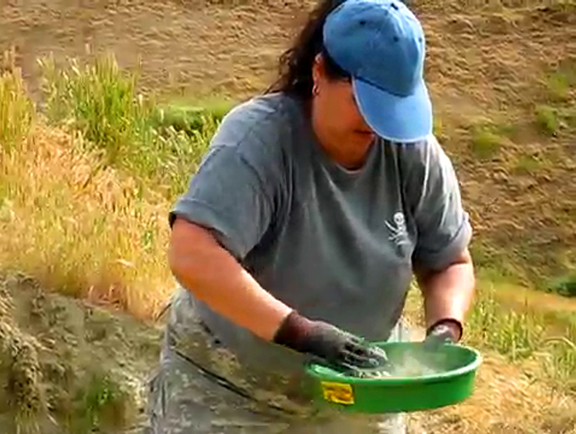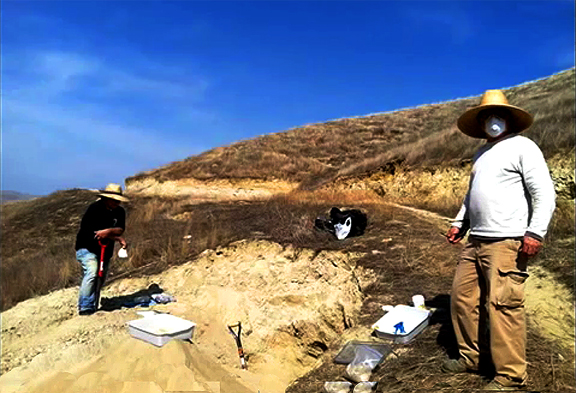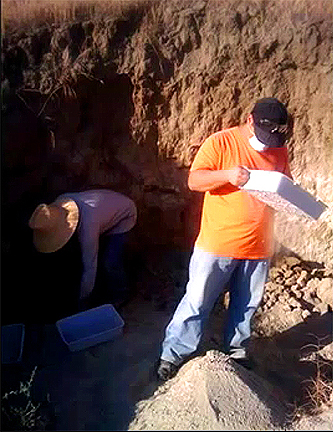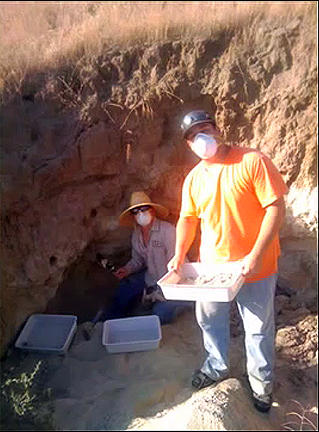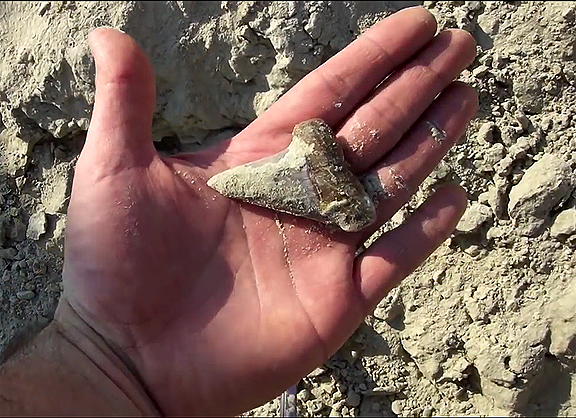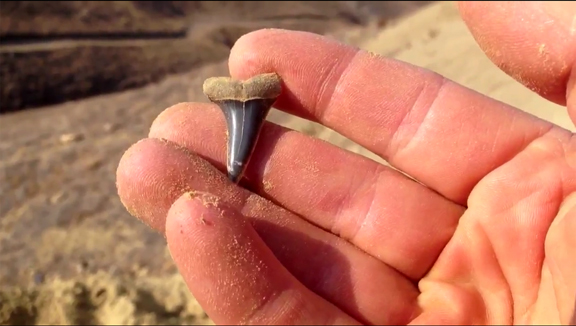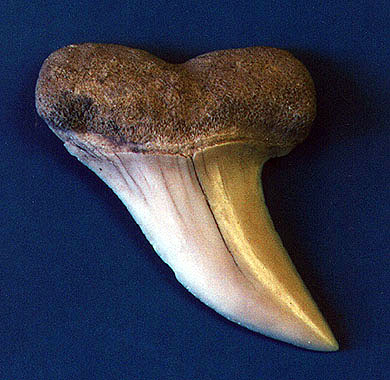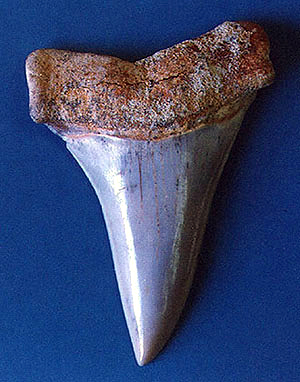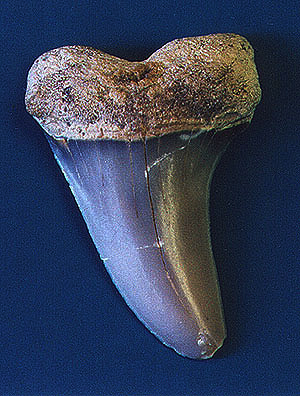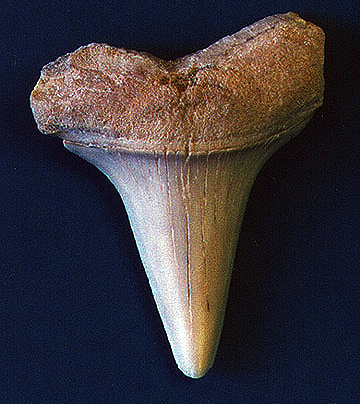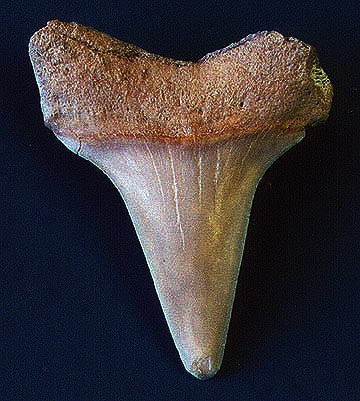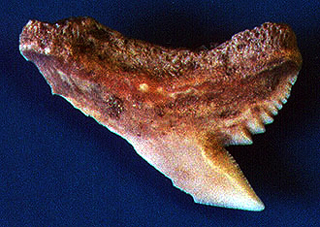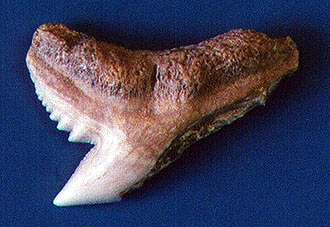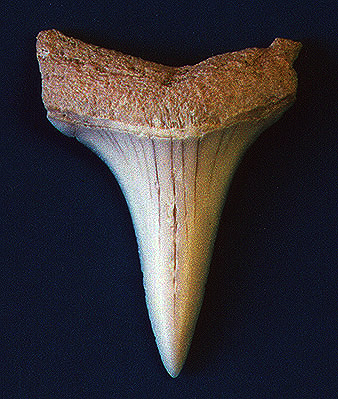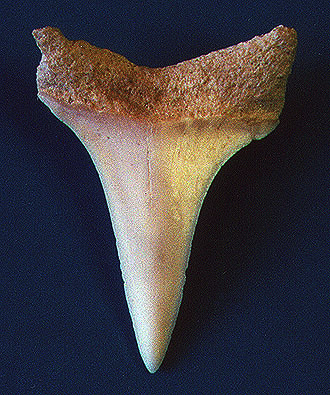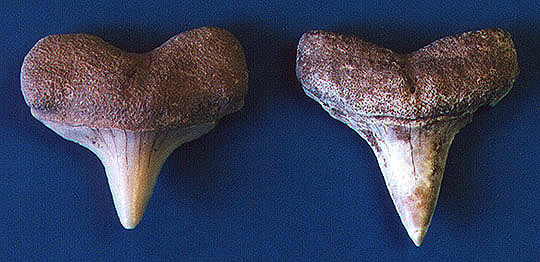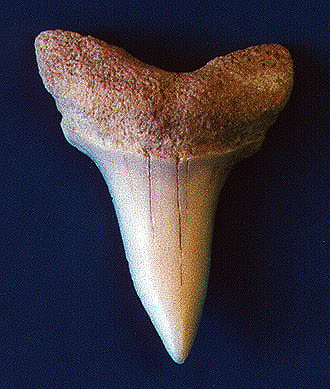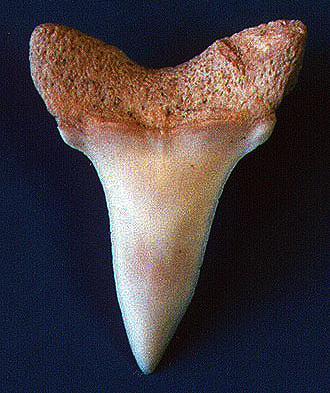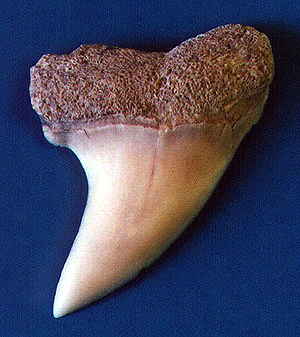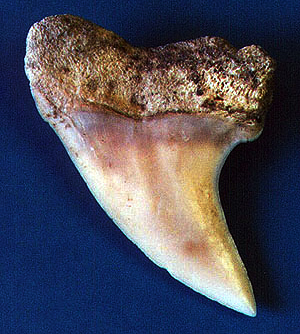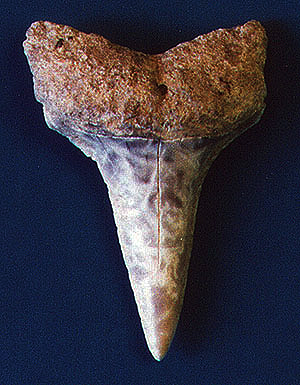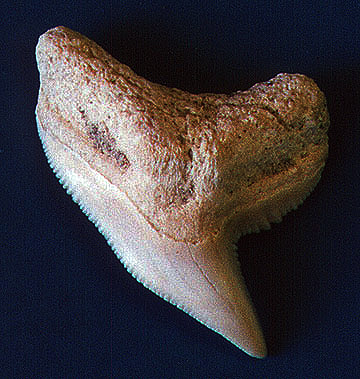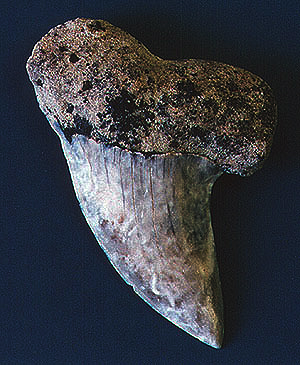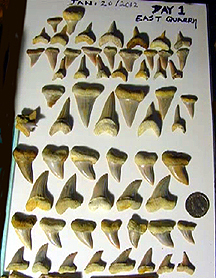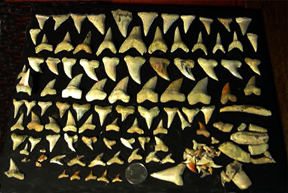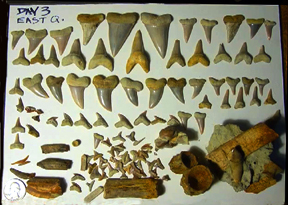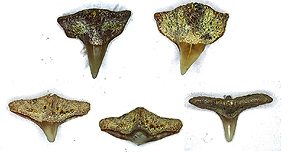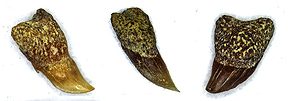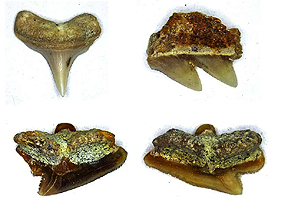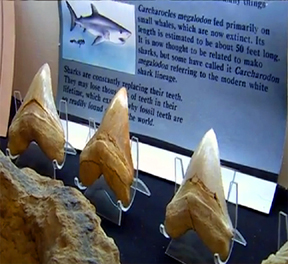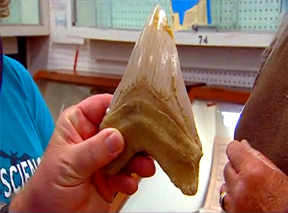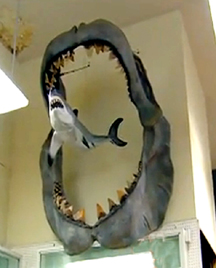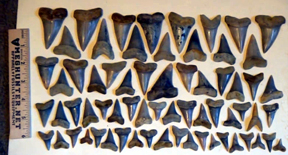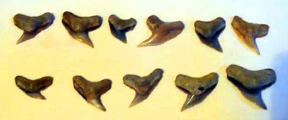|
Many fossil prospectors across America are familiar with
the name Sharktooth Hill. This is an old and venerable locality,
where innumerable shark teeth and marine mammal bones have been
collected over the years. It is certainly one of the most famous
vertebrate fossil sites in the world--a place where roughly 125
species of sharks, bony fishes, sea mammals, sea turtles, marine
crocodiles, birds and even land mammals have been found.
The fossils are concentrated in a rather narrow one-to
four-foot thick layer in the Round Mountain Silt Member of the
Middle Miocene Temblor Formation, which is exposed over several
square miles in the erosion-dissected western foothills of California's
southern Sierra Nevada. Although the diggings at Sharktooth Hill
have historically yielded the most prolific occurrences of the
16 to 15 million-year-old vertebrate material in the Round Mountain
Silt, the so-called Sharktooth Hill bone bed continues to provide
collectors with nicely preserved fossils wherever it outcrops.
This is indeed fortunate for amateur paleontology students,
since Sharktooth Hill presently lies on private property and
is in fact a registered national landmark; unauthorized collecting
is obviously forbidden at that most famous of sites, but several
other fossil-bearing zones in the immediate vicinity can still
be explored by interested amateurs--at least by direct permission
from the many local landowners, who presently own almost all
of the Sharktooth Hill bone bed exposures not included in the
Sharktooth Hill paleontological preserve.
And there is certainly no doubt about it--lots of folks
over lots of historical time have visited the Sharktooth Hill
area to investigate its Middle Miocene marine vertebrate paleontological
preeminence.
The history of fossil collecting at Sharktooth Hill goes
all the way back to the middle portion of the 19th Century. In
August of 1853 geologist William P. Blake reported the occurrence
of well-preserved shark teeth and sea mammal bones from the general
area of present-day Sharktooth Hill. At the time, Blake, employed
by the United States Topographical Corps, was conducting a field
survey for possible railroad routes from the Eastern Seaboard
to the West Coast. His discovery is generally heralded as the
first confirmed report of fossil shark teeth west of the Rocky
Mountains. Blake's important collection was eventually studied
in 1856 by the legendary Swiss geologist and paleontologist Louis
Agassiz, who at the time was one of the leading authorities on
vertebrate fossils.
Sometime after Blake's discovery, enthusiastic amateurs
began to explore the Middle Miocene deposits in the dusty hills
northeast of present-day Bakersfield. Nobody knows for sure who
first coined the name "Sharktooth Hill" to describe
the rich fossil occurrences, but there is little doubt that the
term accurately identifies the most popular type of fossil found
there. Even today, in the centuries after the original find by
geologist Blake, well-preserved shark teeth continue to attract
considerable attention.
As the population of the southern San Joaquin Valley and
of metropolitan Los Angeles (only 90 miles south of Bakersfield)
began to increase during the latter half of the 1800s, so did
the numbers of regular visitors to Sharktooth Hill. From the
beginning of its popularity, the site became a mecca of sorts
for fossil hunters. Shark teeth and sea mammal remains in the
middle of an arid valley, over 100 miles from the Pacific Ocean,
became irresistible attractions and have drawn innumerable individuals
to this site over the decades.
Perhaps the most famous amateur collector to visit Sharktooth
Hill was Charles Morrice, a clerk for the Pacific Oil Company.
Morrice became ardently interested in collecting fossil specimens
from the bone bed in 1909 during his off-work hours. Over the
course of several years he personally excavated hundreds of thousands
of shark teeth weighing, literally, several tons. There is a
historically valuable photograph of the legendary Morrice in
the informative reference volume, History of Research at Sharktooth
Hill, by Edward Mitchell (published by the Kern County Historical
Society in 1965); Morrice is shown on-site at Sharktooth Hill,
by one of his many digs, with a huge bucket filled to the brim
with nicely preserved shark teeth of all kinds. At first, Morrice
would simply give his finds away to friends, relatives and acquaintances.
But he eventually became an indefatigable, scientifically motivated
collector, donating his exhaustive collections to museums and
universities throughout the world. In recognition of his contributions
to science, two extinct animals from the Sharktooth Hill bone
bed have been named in honor of Charles Morrice: a shark, Carcharias
morricei, and a sperm whale, Aulephyseter morricei.
In later years, the two most important amateur collectors in
the Sharktooth Hill bone bed were Bob Ernst (who before his passing
collected upwards of 2 million vertebrate remains) and Russ Shoemaker,
private land owners in the Sharktooth Hill district who donated
exhaustive amounts of Middle Miocene vertebrate fossil material
to any number of museums and scientific institutions throughout
the world.
Although the prolific bone bed at Sharktooth Hill had been
known to paleontologists since the 1850s, the first formal scientific
investigation of the fossil-bearing layer was not conducted until
1924. That year the California Academy of Sciences initially
decided to spend four months in the field analyzing the fossil
deposit on-site. But the diggings proved so productive and challenging
that the Academy continued to collect there, off and on, through
the 1930s. After the preliminary fieldwork was completed, paleontologists
required several years to clean, catalog and identify the abundant
material recovered. In all, some 18 new species of mammals, birds,
sharks, rays and skates were named from the collections amassed.
From 1960 to 1963 a second major scientific study of the
Sharktooth Hill bone bed was undertaken, this time by the Natural
History Museum of Los Angeles County. To expose an undisturbed
layer of the fossil-rich zone, researchers bulldozed away roughly
15 feet of the barren silty overburden. Using whisk brooms and
awls, the scientific teams then carefully removed the essentially
in-place bones and teeth from the 16 to 15-million-year-old sediments.
This was the first time that paleontologists had actually been
able to observe firsthand the relationships of the fossils as
they lay preserved in the bone bed. Thus, not only were innumerable
perfectly preserved bones and teeth recovered, but invaluable
information was also gathered on how the remains of the preserved
animals came to rest on the silty floor of a Miocene sea. A major
highlight of the museum excavations was the discovery of an almost
fully intact skeleton of the extinct sea lion, Allodesmus.
Since articulated remains of marine mammals are uncommon in the
primary bone-bearing zone, such a complete specimen ranks as
one of the most significant finds in the history of explorations
at Sharktooth Hill. Another mostly complete, articulated Allodesmus
was discovered in deposits above the bone bed many years
later by the dedicated amateur fossil hunter Bob Ernst, who donated
the remains to science--a fine sea lion specimen now housed at
the Buena Vista Museum in Bakersfield.
Perhaps the zenith of paleontological investigations at
Sharktooth Hill happened during the 1960s and 1970s. Research
crews from universities and museums throughout the United States
visited the area, carting away tons of excellently preserved
fossil material. Amateur interest in the bone bed also increased,
and many a Southern Californian was likely first introduced to
the rewards of fossil hunting at Sharktooth Hill.
But the steady stream of visitors appeared to be getting
out of hand. Much of the precious bone-bearing horizon was rapidly
disappearing. Scientists expressed justifiable concerns that,
if left unprotected, the most fossiliferous sections of the bone-yielding
horizon would soon be obliterated. The proper government officials
agreed with this assessment and in May, 1976, Sharktooth Hill
was added to the United States Landmark Registry, a designation
which protects the locality from unauthorized collectors.
The Sharktooth Hill bone bed has provided paleontologists
with the single largest assemblage of Middle Miocene marine vertebrate
animal fossils in the world (the famous Miocene Calvert Formation
of Maryland also produces many kinds of marine vertebrate remains).
The impressive list of marine mammal specimens alone from the
Temblor Formation includes dolphins and dolphin-like creatures,
porpoises, sea lions, whales, sea cows, walruses, seals and an
extinct hippopotamus-like fellow called Desmostylus--a
10-foot-long animal related to the elephant that evidently walked
around on the sea floor crushing shellfish with its massive,
powerful jaws. Also identified have been extinct large turtles,
a marine crocodile, many kinds of bony fishes, and some 20 species
of birds--in addition to the astoundingly abundant sharks and
rays.
In addition to the marine fauna, several skeletal elements
from land mammals have also been taken from the fossil beds.
These include a lower jaw of the mustelid (weasel-like) Sthenictis
lacota; a lower jaw of the huge amphicyonid, or "beardog"
Pliocyon medius; the dog Tomarctus optatus; the
three-toed horses "Merychippus" brevidontus
and Anchitherium sp.; the rhinoceroses Aphelops megalodus
and Teleoceras medicornutum; the tapir Miotapirus sp.;
the deer-like dromomercyids Bouromeryx submilleri and
Bouromeryx americanus; the protoceratid (sort of a cross
between a modern deer and a cow) Prosynthetoceras sp.;
and the gomphothere (an extinct proboscidean) Miomastodon
sp. Such remains are exceedingly rare, though, and are usually
considered anomalies in the local Middle Miocene fossil record.
Their presence in proved marine-deposited rocks points to preservation
in shallow sea waters, since it is unlikely that the carcasses
of land animals could have been transported far from the ancient
shoreline before they settled to the ocean floor.
All of these remains lie waiting to be uncovered in the
rolling brush-covered western foothills of the southern Sierra
Nevada, several miles northeast of Bakersfield in Kern County,
California.
One of the better extensions of the fabulous bone bed was
for decades a genuinely fun and educational place to visit. Here,
shark teeth and various fragmental skeletal elements from a variety
of marine mammals constituted the available fossilized assemblage,
a place that for many years amateur collectors were welcome to
visit; on any given day of the week, for example, one could expect
to find at least a handful of folks (on weekends, the numbers
of visitors increased exponentially) exploring the prolific Middle
Miocene fossil horizon, collecting loads of well preserved shark
teeth and generally enjoying their outdoor experience without
having to worry about legal restrictions on their fossil-hunting
activities. The local law enforcement and BLM authorities left
the collectors alone, as long as the area remained free from
litter and vandalism, of course. When I last visited the locality,
enthusiastic visitors were still allowed to gather Middle Miocene
shark teeth and miscellaneous sea mammal bones, but there is
no guarantee that the area has remained accessible to unauthorized
amateurs. If the site has been formally closed off, make certain
that you obey all the rules and regulations: do not attempt to
climb over a locked gate, or with reckless disregard disobey
No Trespassing signs which may have sprung up to warn visitors
that their presence is no longer welcome.
Upon stepping out of one's vehicle to survey the territory,
where to search for the fossilized specimens was quite obvious
to all visitors. Along the steep to moderately inclined slopes
above the parking area one could observe the unmistakable World
War I-style infantry entrenchments that, dipping at a low angle
of approximately four to six degrees to the southwest, marked
the trend of the prospected bone bed. These excavations were
made by armies of a different sort: fossil hunters who in their
determination to recover shark teeth and marine mammal bones
had created a single extended trench along the entire length
of the exposed fossiliferous horizon in this immediate area.
The shark tooth-bearing layer averaged roughly one foot
thick here, but was often difficult to spot due to the random
digging of previous fossil prospectors. It helped to watch for
the dark-brown fragmental bones of sea mammals embedded in the
pale-gray matrix of the Round Mountain Silt; these were the most
common finds in the Sharktooth Hill bone bed exposures, although
the perfectly preserved shark teeth remained the prized items
sought by the majority of visitors. The best way to locate fossils
was to settle into your "battlefield" entrenchment
and commence digging. Here, there was just no substitute for
good old-fashioned manual labor. Most collectors simply dug into
the fossil-bearing zone with a pick or shovel, carefully inspecting
each chunk of Middle Miocene material removed from the exposure.
Others brought along some kind of screening device--even a riddle
(usually employed by gold seekers)--into which they dumped fossil-bearing
dirt. After the sands and silts had passed through the fine mesh,
any bones and teeth scooped up remained atop the screen, ready
to be packed away for safekeeping.
Unfortunately, the fossil zone was not as prolific as at
classic Sharktooth Hill, where almost any section of the bone-yielding
horizon explored managed to yield abundant perfectly preserved
material. Weathered-free fossils were sometimes found, too, especially
after a heavy rainy season, before the hordes of eager collectors
had descended on the hill for a new season of fossil-finding;
at the once-accessible locality, though, freely eroded forms
were conspicuously absent. This was best explained by the great
numbers of collectors who visited the site each year. Any remains
that had naturally washed out of the 16 to 15-million year-old
sediments were in all likelihood immediately plucked up and stored
away by the lucky few who happened upon them. As this specific
locality remained for many years the primary spot where amateurs
were still legally allowed to collect fossils from the Sharktooth
Hill bone bed, it was not surprising that such easy pickings
were nonexistent.
Other than keeping well-hydrated during hot summer days,
the major hazard one faced at the fossil locality, and indeed
wherever one happened to dig into the Sharktooth Hill bone bed,
was exposure to Valley Fever. This is a potentially serious illness
called scientifically, Coccidioidomycosis--or "coccy"
for short; it's caused by the inhalation of an infectious airborne
fungus whose spores lie dormant in the uncultivated alkaline
soils of California's southern San Joaquin Valley: And the region
in which the Sharktooth Hill bone bed occurs is known to contain,
in places, significant concentrations of the spores which cause
this disease. When an unsuspecting and susceptible individual
breaths the spores into his or her lungs, the fungus springs
to life, as it prefers the moist, dark recesses of the human
lungs (cats, dogs, rodents and even snakes, among other vertebrates,
are also susceptible to "coccy") to multiply and be
happy. Most cases of active Valley Fever resemble a minor touch
of the flu, though the majority of those exposed show absolutely
no symptoms of any kind of illness; it is important to note,
of course, that in rather rare instances Valley Fever can progress
to a severe and serious infection, causing high fever, chills,
unending fatigue, rapid weight loss, inflammation of the joints,
meningitis, pneumonia and even death. Every fossil prospector
who chooses to visit the Sharktooth Hill bone bed--and the southern
San Joaquin Valley, in general--must be fully aware of the risks
involved.
With regard to the direct risk of contracting Valley Fever
while digging in areas where the Sharktooth Hill bone bed occurs,
a year 2012 posting at the Facebook page of a major commercial,
fee fossil dig operation situated on private property sheds at
least a modicum of light on the subject:
"Question: How many people catch Valley Fever after
digging at your quarries?
"Honestly, more participants have had encounters with
rattlesnakes, than have contracted Valley Fever (VF). Nearly
all of our participants DO NOT use dust masks while digging.
We have had over 2000 diggers on the quarry in the last 18 months,
and we only have 3 reported instances of participants contracting
VF. That falls well belo...w the Kern County average, and may
say something as to the prevalence of the spores in areas we
are excavating. We have four quarries open currently, all located
below the surface, in fossil beds aged between 14 and 18 million
years. This 'soil time-line' predates the emergence of c. immitis
by over 10 million years."
So, here's the bottom line, the proverbial upshot--Valley
Fever spores definitely exist in California's southern San Joaquin
Valley, and Valley Fever can indeed be contracted from digging
in the area where the Sharktooth Hill bone bed occurs. The statistic
that "only" three individuals in 18 months of supervised
digging there have reported contracting Valley Fever may or may
not assuage the justifiable concerns of potential visitors.
The Round Mountain Silt Member of the Tumbler Formation,
which contains the Sharktooth Hill bone bed (and could harbor
fungal spores of Valley Fever--a noncollectible item if there
ever was one), apparently accumulated roughly 16 to 15 million
years ago in a semi-tropical embayment. This great body of water
covered all of the present-day San Joaquin Valley from the Salinas
area southward to the Grapevine Grade, just north of Los Angeles.
The incredible bone bed was evidently preserved along the southeastern
edges of the sea in waters no deeper than about 200 feet--an
estimate based on the presence of fossil rays and skates, whose
modern-day relatives prefer such relatively shallow depths. It
is illuminating to note that all of the living members of the
fossil fauna recovered from the bone layer can be found today
in Todos Santos Bay off Ensenada, Baja California Norte; the
extant marine mammals of the Sharktooth Hill fauna all migrate
there during the winter months.
While scientists understand very well the variety of animals
that formerly lived in the Middle Miocene Temblor-period sea,
they are less certain of what caused restricted preservation
in such a narrow bed in a locally unfossiliferous deposit. Although
the Temblor Formation does yield moderately common fossil mollusks
and echinoids elsewhere in its area of exposure (Reef Ridge in
the Coalinga district, for example), the Sharktooth Hill bone
bed occurs in sediments that are mysteriously barren of any other
kinds of organic remains. In an interval several hundred feet
both above and below the bone-bearing horizon there is absolutely
no trace of past animal or plant life.
Typically, such a shallow marine environment as is suggested
by the bone bed would be expected to include many sand dollars,
gastropods, pelecypods and a wide variety of microscopic plants
and animals such as diatoms and foraminifers. But such is not
the case here. Even after decades of assiduous, dedicated scientific
examination, vertebrate animal specimens remain the only diagnostic
types of fossil specimens yet recovered in abundance from the
Sharktooth Hill bone bed (a few internal casts of gastropod and
pelecypod shells have also been reported from the bone bed, in
addition to occasional coprolites, invertebrate burrows, and
gypsum-coated pieces of petrified wood--none of which is particularly
significant or diagnostic, except to say that such occurrences
support the idea that the bone bed formed in relatively shallow
waters).
Such an unusual abundance of diverse species of marine
mammals, sharks, birds, rays, skates and even land mammals requires
a unique mechanism of preservation. Clearly the curious mixing
of both land and marine vertebrates in the same layer points
to an as-yet incompletely understood set of circumstances. Needless
to report, ever since the bone bed's discovery on that summer
day way back in 1853, investigators have wondered just what events
could have created such a remarkable concentration of vertebrate
remains in a narrow horizon, to the exclusion of all other marine
invertebrates normally associated with a shallow-water environment.
Several ideas have been advanced to explain the rare occurrence.
One of the earliest explanations was offered during the
first quarter of the 20th Century by paleontologist Frank M.
Anderson of the California Academy of Sciences. Anderson suggested
that violent volcanism in the region poisoned the Miocene waters
with ash and noxious gasses, causing the sudden extinction of
the fauna. While it is true that widespread volcanic activity
occurred in the Middle Miocene of the present-day San Joaquin
Valley, there is no direct evidence to suggest that the Sharktooth
Hill fauna was adversely affected by it.
A second hypothesis states that during the Middle Miocene,
the bay in which the Sharktooth Hill animals lived became landlocked.
As the waters gradually evaporated the unlucky inhabitants were
doomed to try to survive in an increasingly smaller area, until
at last the creatures succumbed, thus creating a narrow zone
in which their skeletal and tooth remains were concentrated.
Yet another explanation concerns the "red tide"
phenomenon. Occasionally, a toxin-producing marine microbe multiplies
so rapidly that it kills smaller fish by the millions. The organism
contains a minute amount of a potent poison that can be easily
concentrated in the food chain. Larger fish consume the smaller
types that feed on the lethal organism until, eventually, all
of the fish are killed.
An additional once-popular proposal was that the Middle
Miocene Sharktooth Hill area was a great calving ground for marine
mammals, an irresistible attraction for sharks who seasonally
feasted on the animals gathered there to give birth. Unfortunately,
there is a paucity of juvenile sea mammal bones in the deposit--not
the amount one would reasonably expect to find preserved in the
Round Mountain Silt Member of the Temblor Formation had the area
witnessed for thousands upon thousands of seasons youngsters
cavorting in the same warm waters that held their predators--the
sharks.
Other possible mechanisms of deposition proposed for the
famed bone bed are turbidity currents--which are masses of water
and sediments that flow down the continental slope, often for
very long distances. Presumably, the carcasses of sea and land
animals were caught up in such underwater sediment flows, their
bones transported for considerable distances before the remains
dropped out of suspension in a submarine canyon, far removed
from the Middle Miocene shoreline. Perhaps favoring this explanation
is the fact that many of the vertebrate remains from the bone
bed reveal obvious signs of wear and tear, suggesting some degree
of transport and agitation prior to their eventual burial. As
a matter of fact, this is the one specific scenario of bone deposition
that most closely matches the evidence; indeed, it's the single
most widely accepted method by which literally millions of sea
mammal bones and shark and ray teeth could have possibly been
preserved in such a narrow interval, to the exclusion of virtually
every other kind of marine life.
This is but a sampling of the ideas proposed to account
for the Sharktooth Hill bone bed. Unfortunately (for the theorists
who suggested them), all but one of the above proposals--the
turbidity current idea, specifically--are quite simply put flat-out
wrong. They have been disproved, falsified. Over the years, there
have probably been as many hypotheses advanced as there are scientific
speculators to invent them. Suffice it to say that no one single
explanation, save the turbidity current proposal, has yet been
delivered to answer all the questions posed by this famous bone
bed of the Middle Miocene.
In early 2009, though, some researchers claimed that the
problem had been solved once and for all. The "definitive"
explanation--as published by The Geological Society Of America
in a paper entitled, "Origin of a widespread marine bonebed
deposited during the middle Miocene Climatic Optimum" by
Nicholas D. Pyenson, Randall B. Irmis, Jere H. Lipps, Lawrence
G. Barnes, Edward D. Mitchell, Jr., and Samuel A. McLeod--is
that the Sharktooth Hill Bone Bed accumulated slowly above a
local disconformity over a maximum of 700 thousand years due
to sediment starvation timed to a major transgressive-regressive
cycle during middle Miocene times 15.9 to 15.2 million years
ago. The upshot here, according to the authors, is that the world-famous
bone-bed is not the product of a mass dying, neither is it the
inevitable result of red-tide poisoning, nor the remains of animals
killed by volcanic eruptions, nor the preservations of vertebrates
through the concentrating action of turbidity currents--not even
the site of a long-term calving region where sea mammals birthed
and sharks hunted can fully explain the fabulous bonanza bone
layer. The Sharktooth Hill Bone Bed came about, the scientists
claim, over thousands of years due to slow, steady bone accumulation
during a period of geologic time when very little clastic sedimentation
(sands and silts and muds) occurred.
Perhaps this new research has indeed finally resolved the
mysteries surrounding the deposition of likely the greatest concentration
and diversity of fossil marine vertebrates in the world. The
turbidity current idea still holds water (pun intended) for many,
though, and will likely remain a lasting viable explanation for
many folks in the paleontological and geological communities.
Research on the Sharktooth Hill area has been exhaustive,
to say the least. Reference materials on the subject abound.
Probably the single best book to consult is the aforementioned
History of Research at Sharktooth Hill, Kern County, California,
by Edward Mitchell. Other worthwhile works include Birds from
the Miocene of Sharktooth Hill, California, in Condor,
Volume 63, number 5, 1961, by L.H. Miller; Sharktooth Hill,
by W.T. Rintoul, 1960, California Crossroads, volume 2, number
5; and the July 1985 issue of California Geology, published by
the California Division of Mines and Geology, in which an excellent
article appears entitled, Sharktooth Hill, Kern County, California,
by Don L. Dupras.
The once-accessible locality used to make a terrific substitute
for Sharktooth Hill. While the fossil remains were obviously
not as plentiful as at the more-famous site, amateur collectors
and professional paleontologists alike continued to find many
beautifully preserved shark teeth and marine mammal bones in
the fabulous Sharktooth Hill bone bed. It is a world-class paleontological
deposit which has yielded some 125 species of vertebrate animals
from the Middle Miocene of 16 to 15 million years ago--a time
when a tranquil semi-tropical sea similar to Todos Santos Bay
off Ensenada covered the present San Joaquin Valley. It was a
time when the ancestors of great white sharks lived where vast
fruit orchards now grow in the agriculture-rich Great Central
Valley of California.
|
